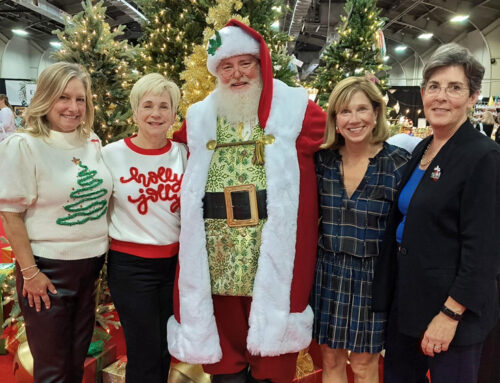Think about your typical morning routine: Your alarm clock wakes you, you grab a cup of coffee or a slice of toast, maybe flip on the TV for the day’s news. Later, you’ll brush your teeth before heading to work in your car. In just that short scenario, you would have already used eight patented inventions.
Inventors have advanced our nation considerably, and they’re still breaking new ground today. Our neighborhood is no exception — it’s filled with innovative minds, ready to bring us that next thing we just can’t live without. Over the past decade, Dallas has averaged about 735 patents per year, according the United States Patent and Trademark website. It’s safe to say that around here, there’s a steady stream of bright ideas.
But it takes more than just a “eureka” moment to be a successful inventor.
“It takes a lot of time and research, and it’s very expensive — I had to pull some money out of a retirement account to pay for this,” says Lakewood inventor Vic Vines. “As far as beating the odds, it’s been an expensive poker game to this point.”
The U.S. Patent and Trademark Office says all inventors can expect to pay at least $4,000 to get their patents granted, and on average, most end up paying more in the neighborhood of $5,000-$10,000. And getting that patent doesn’t just take money; it also takes time — about 22 months to be exact.
After all that, inventors still aren’t guaranteed their product will ever see the light of day. Only two to three percent of inventions actually ever make it to the marketplace, according to Entrepreneur magazine.
But that’s not stopping the inventors we talked to. These neighborhood inventors have original ideas they believe could be the next big thing.
We’ll let you be the judge.
Debbie Alspaw and Alicia Harris
Storybook photo albums
The lightbulb: “The idea came to me as I was putting my kids to bed,” says Alspaw, an artist who now owns the Artzy Smartzy art studio in Lake Highlands. “I was wanting something the kids could read about themselves that had pictures of them.” The result was “All About Me,” a photo album telling the page-by-page story of a child growing up. Each page is decorated with Alspaw’s watercolor creations and contains a 3.5- by 5-inch spot to affix a photo.
The journey: At first, Alspaw hand-painted the books and sold them at stores that were stocking her greeting cards. The response was good, so she decided to team up with her friend, neighborhood resident and freelance writer Alicia Harris, to create a second book called “All God’s Creatures.” The pair applied for a patent on the photo albums and received it in 1997, right as the scrapbooking craze was beginning. Alspaw and Harris started promoting the books at home craft shows, then selling them at small children’s stores and boutiques in Dallas and throughout Texas. They even traveled to a booksellers convention in Chicago to promote their product to retailers across the nation. The women made some headway, but they were struggling to find the right person to market the product. “It was not making money, and I think our enthusiasm waned and we realized what we were up against,” Harris says.
The future: They’ve sold more than 1,000 books, and Alspaw still stocks them in her studio (for $12.95), but the pair is letting the patent expire and focusing on other projects for now — Alpaw on her art classes, and Harris on her screenwriting. “I really believe that if we somehow would’ve gone down the right path … ,” Harris reflects. “You have to try stuff. I know people who are inventors who have tried and failed and tried and failed, and you just have to keep at it.” If they never attempt another patent, it won’t be for a lack of fresh ideas. What they need next time, the women say, is good marketing and financial backing. “We know we had a good idea because of the response that we had,” Alspaw says. “I would not trade the experience for anything, and it’s something that, if we had the money, we would do it again.”
Michael Stephenson
Portable pool cleaner
The lightbulb: Stephenson, a self-described “pool boy” with a swimming pool maintenance and repair business, used to clean pools at Power Properties apartment complexes in the neighborhood. Because of their age, some of the pools weren’t plumbed with a power line where he could plug in his automatic pool sweeper, so Stephenson had to vacuum them by hand. “You’ve seen the guys with a long pole and corrugated hoses — Walter Mattheau in ‘Bad News Bears,’ that kind of thing, just slugging away,” he says. “And they had six of these.” So to lighten his load, he came up with a portable contraption that could operate a sweeper from a pool’s ledge.
The journey: Stephenson fashioned the device — “basically a poolside pressure pump,” he says — to plug into any power outlet, and built it with a filter, timer and safety device, “like the little red button in your bathroom,” he says, “so if this thing happens to fall into the pool or it gets splashed, then the electricity’s turned off and no one gets hurt.” When he began using it at the apartment complex pools, Stephenson cut down his cleaning time from two hours per pool to three hours for all six. “I made these for myself to use on the job, and then somebody told me I should patent it,” he says. He received the patent last year, but hasn’t yet been able to find a company that wants to license it.
The future: Stephenson is still searching for a taker. The product would be ideal for people who have older pools, he says, because it would probably retail between $500 and $600 as opposed to the minimum $2,000 it would cost to add a power line. “And there would be no digging your yard up, no breaking concrete out, no digging down so a guy can make a hole 12 inches thick,” Stephenson says. “That’s just a pain.” But even if nothing ever comes of it, Stephenson feels proud to call himself an inventor. Besides, he has a few more ideas up his sleeve. “I think they’re even better,” Stephenson says. “I’d tell you, but I’d have to kill you.”
Johnny de la Valdene and Kim Raymond
Marshmallow Shooter ($24.99)
The lightbulb: It was a 2004 birthday party for Raymond’s son that kicked off what could now be considered a marshmallow empire. Raymond handed out PVC pipes and mini marshmallows, and a full-blown war broke out with the kids using lungpower to launch the treats at each other. “Basically the parents were playing as much as the kids were playing,” de la Valdene says. “We were just astounded at how crazy everybody went over these things.” De la Valdene thought Raymond might be onto something, so he asked an engineer to create a prototype for a marshmallow shooter.
The journey: It wasn’t de la Valdene’s first venture. He and a friend teamed up six years ago to create ShatterSports — 3-D decals that look as if tennis balls, baseballs or other sports gear smashed into a car window. De la Valdene thought of it while working on his Florida ranch. “We have a great engineer who works for us that if we dream it up, he can build it,” he says. That’s how the Marshmallow Shooter was born. De la Valdene and Raymond made sure it was designed to shoot only marshmallows or foam pellets — no rocks. (Even the marshmallows won’t shoot if they get too stale.) The toy hit the market last year and became a Christmas present sensation after it was marketed at the International Toy Fair. More than a million have sold, and 650 specialty stores and 300 catalogs now carry the shooter. It also spawned a long line of marshmallow products: a blower, a blaster (which shoots s’more-sized marshmallows), a bow and mallow (which aims marshmallows instead of arrows), and bags of marshmallows with flavors like bubble gum and coffee. They even created a Marshmallowville storyline complete with comic books and a board game. “Basically Martians are invading the world, and marshmallows is how you combat them,” de la Valdene says.
The future: A Marshmallowville game is in the works for PS3 and Nintendo Wii systems, and de la Valdene is looking for a broadcast and movie deal. (He also runs a television and film production company.) The shooter will soon be on shelves in camo, lunar and clear designs, and a slingshot and battery-operated shooter are coming down the pipeline.
Vic Vines, Vince George and Rusty Kennard
The lightbulb: Of the 4 million babies born each year in the United States, 250,000 to 300,000 are vacuum-assisted deliveries, most commonly when babies are in trouble and need to be pulled out more quickly. The vacuum is placed on the tip of the baby’s head and acts almost like a suction cup, and it’s by and large an effective technique — except for the roughly one in 800 vacuum applications resulting in brain hemorrhages, says Dr. Vic Vines. A veteran obstetrician and gynecologist at Medical City, Vines has performed hundreds of vacuum-assisted deliveries as well as acted as an expert witness in court where the details of such births were contested. One lawsuit in particular troubled him. “If we would have had real time documentation, we would have had no dispute,” Vines says. An idea to resolve such discrepancies awoke him one morning at 2 a.m. — a device that electronically sends information from the vacuum to the fetal monitor (the same machine that measures a mother’s contractions).
The journey: Called VacuLink, the device has four patents (plus two pending) and is the joint effort of Vines and his fellow Lakewood neighbors, Vince George and Rusty Kennard, whom Vines recruited for their respective financial and legal expertise. Now, Vines says, instead of a subjective review of how a vacuum is used during birth, physicians will be able to know exactly how long the vacuum was on a baby’s head and precisely how many pulls and “pop offs” occur. “When you have to rely on your memory in a situation like this, there’s error in that,” Vines says. “When there’s an emergency, the last thing somebody is worried about is the minutia of how something is being used.” “But minutia is very important when something does go wrong,” George says. Medical schools give very little instruction about how to use a vacuum, so most physicians have to rely on on-the-job training, George says. Vines thinks this is what leads to incorrect application of the vacuum — placing it on the side of the head instead of the tip — which is probably what causes pop offs and, many believe, the brain hemorrhages. “I’m convinced there are a lot of docs who use vacuums who have no idea how to use it correctly, and because babies are resilient, they get away with it a lot,” Vines says. Already 20 or so hospitals around the country are using the VacuLink, including Medical City and Presbyterian, and the doctors who use it find that it’s more than simply a recording tool, Vines says. Because the device rolls out the information to doctors and nurses in real time, Vines believes it helps prevent injuries and deaths.
The future: That doesn’t mean physicians are readily embracing the device. “If there’s one problem in selling doctors anything, it’s getting them to buy something that interferes with their autonomy,” Vines says. Obstetricians are second only to neurosurgeons in terms of risk — which translates to a higher chance of getting sued — so the initial introduction to VacuLink makes them a bit nervous. “But the question we have is: If it’s rolling out in real time, why would you do something wrong?” Vines asks. “This thing shows you where you are. Unless you voluntarily do something wrong, it’ll protect you.” Independent dealers and distributors who sell products in labor and delivery rooms are currently promoting VacuLink in roughly 90 percent of the country’s markets. “It’s just not selling anywhere as fast as we hoped,” George says, “but we are making progress.” Their company has also secured worldwide patents, and the men hope to take the product international after increasing domestic sales.





